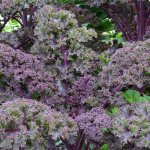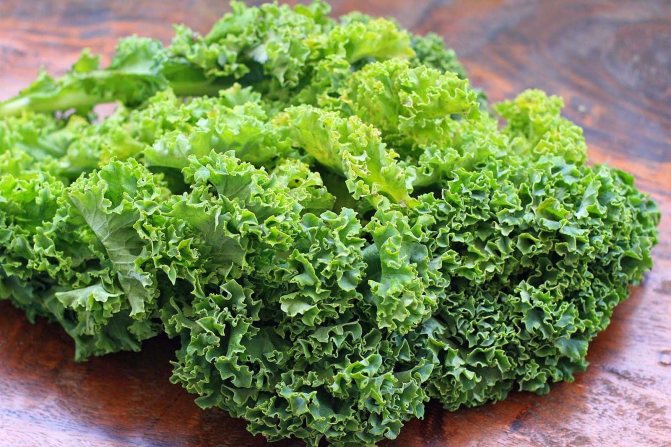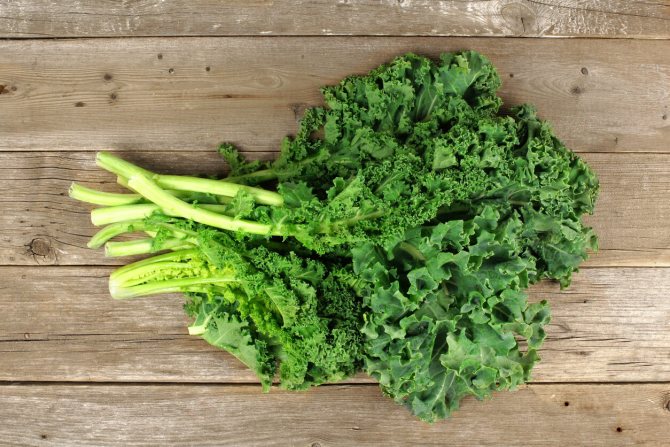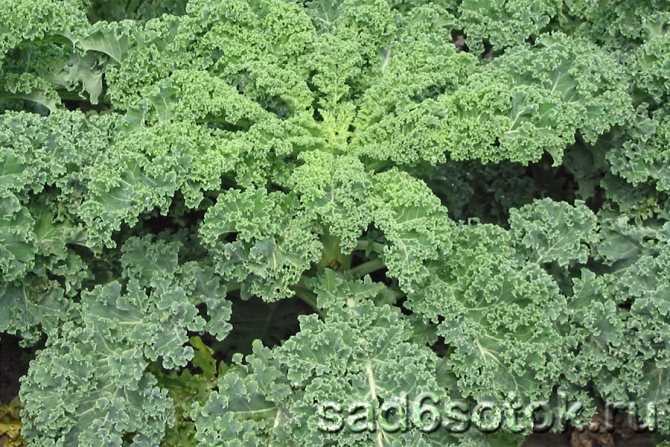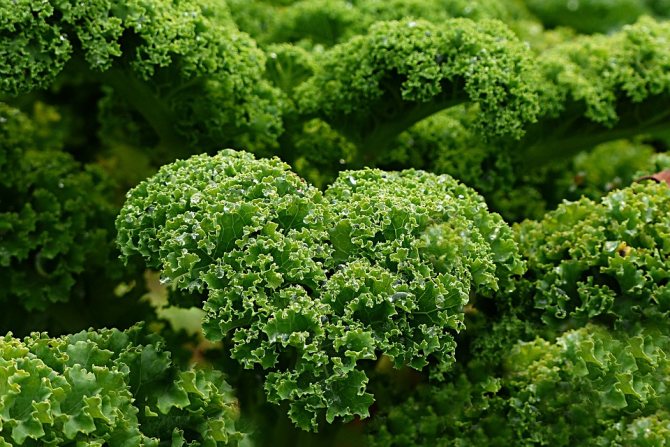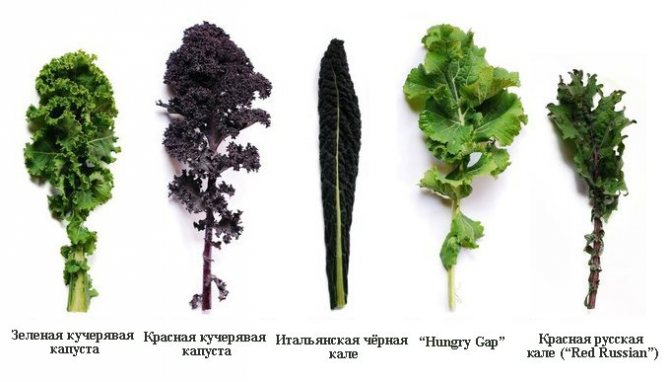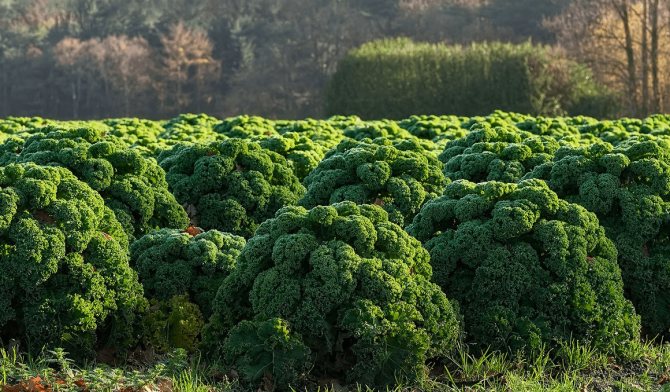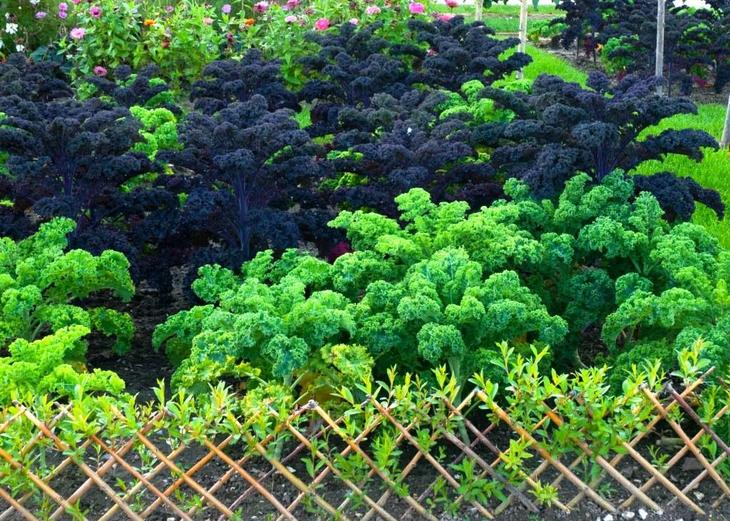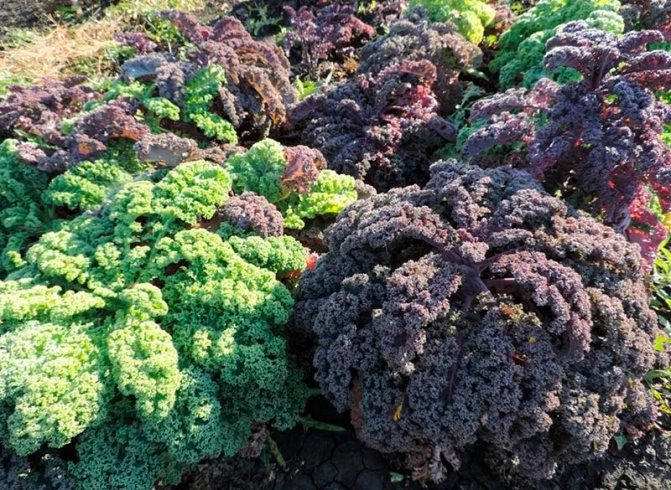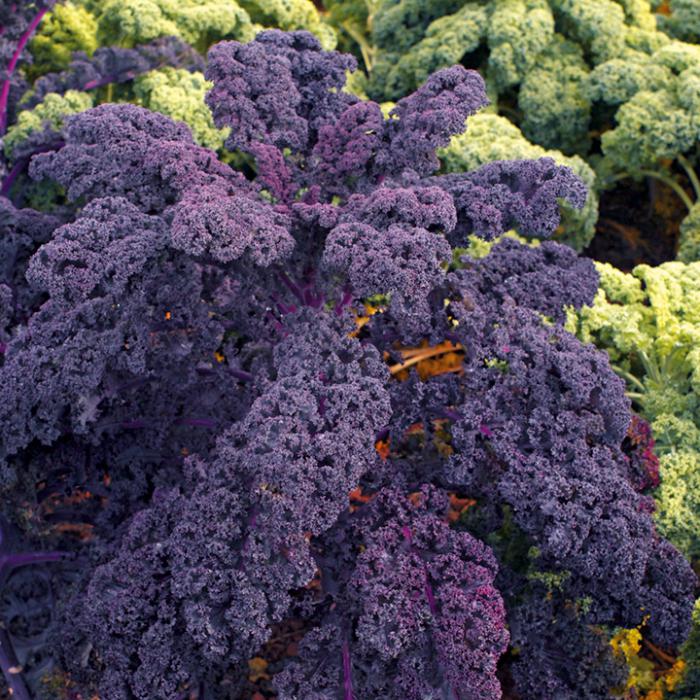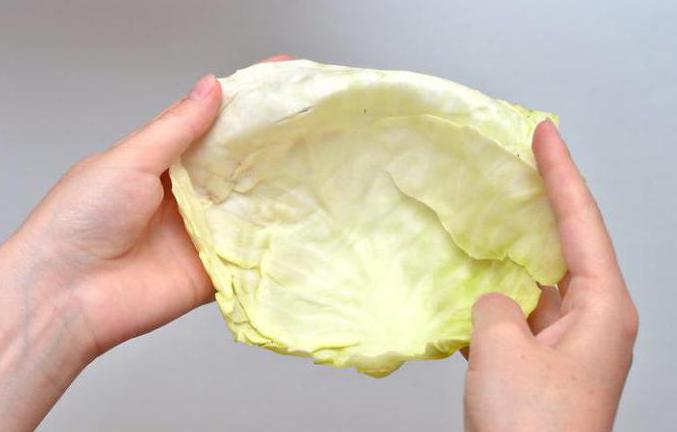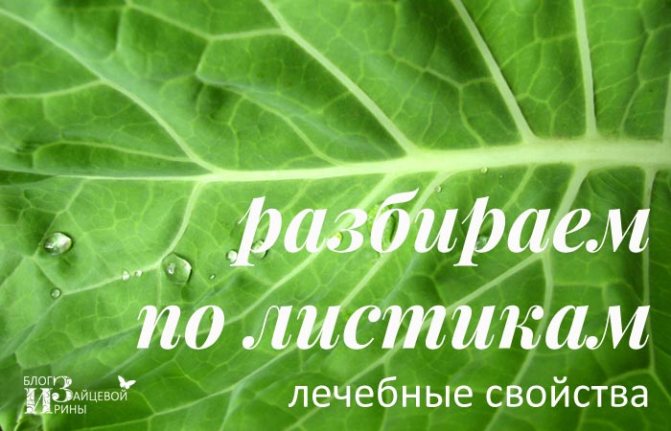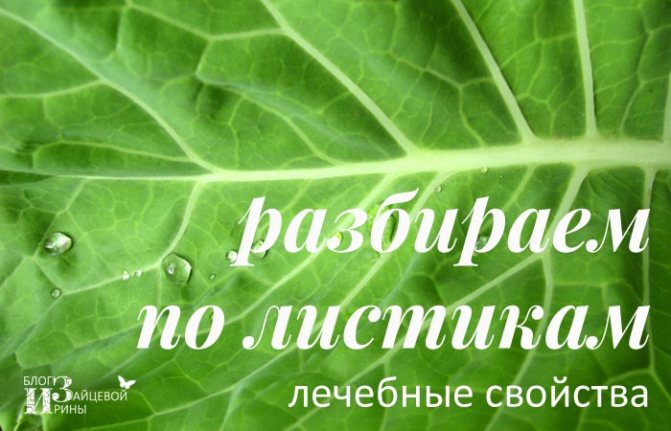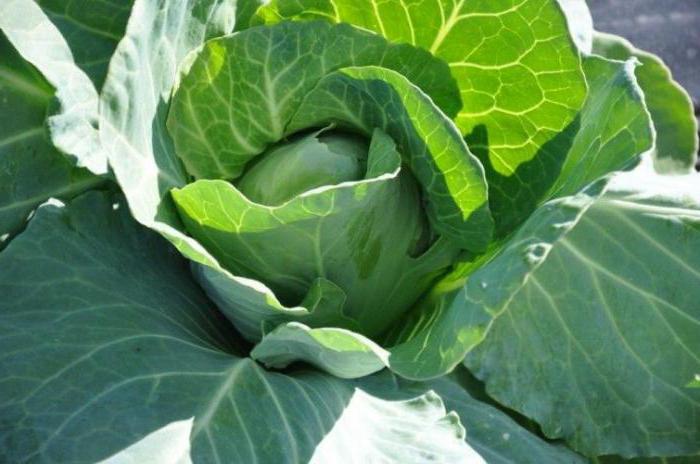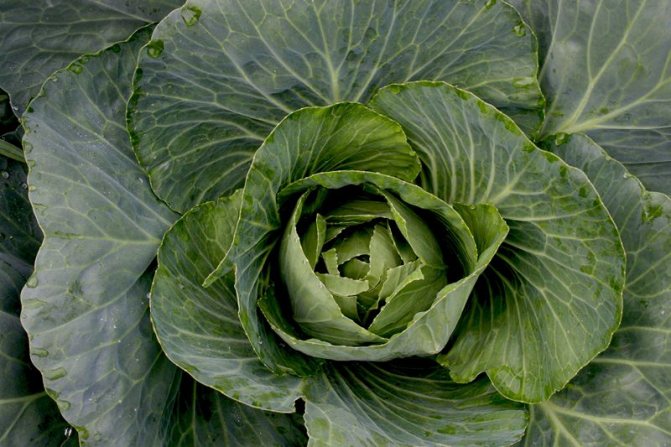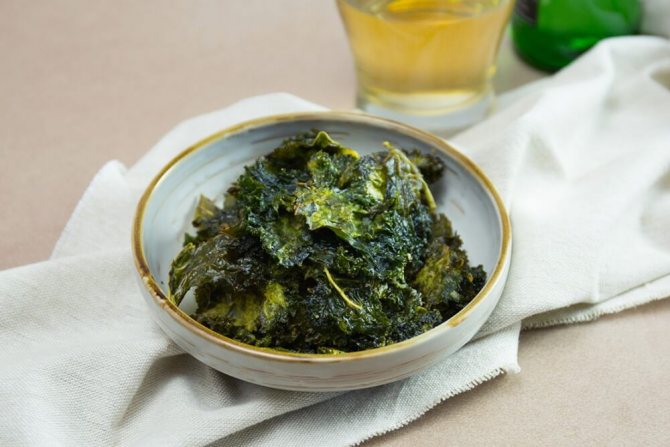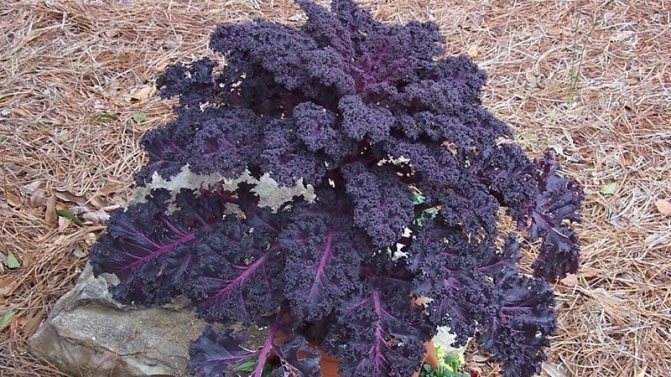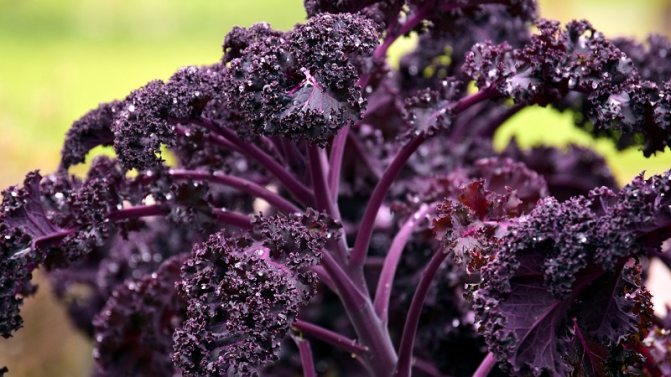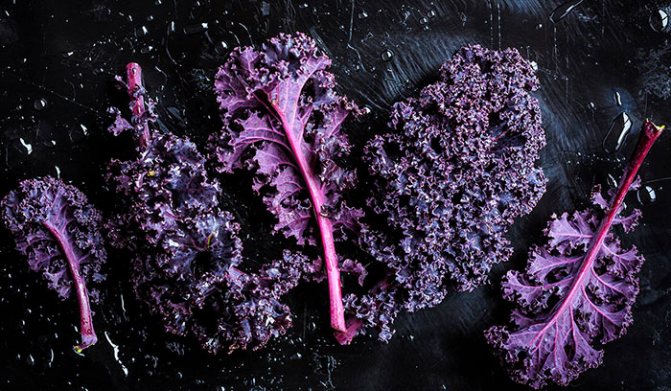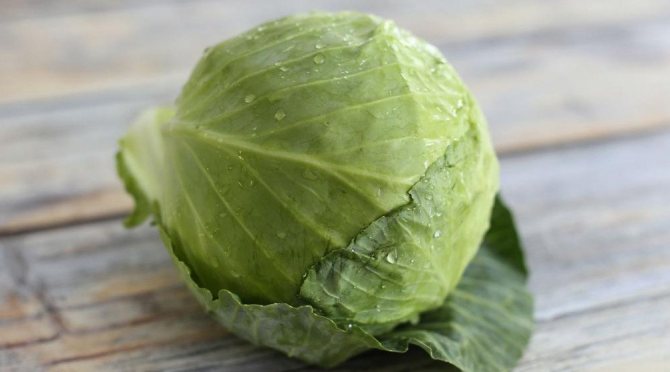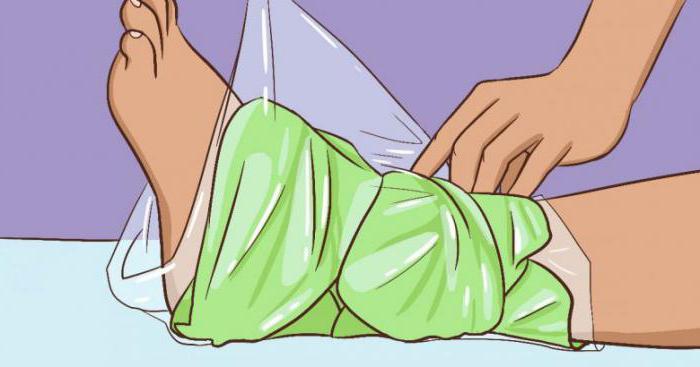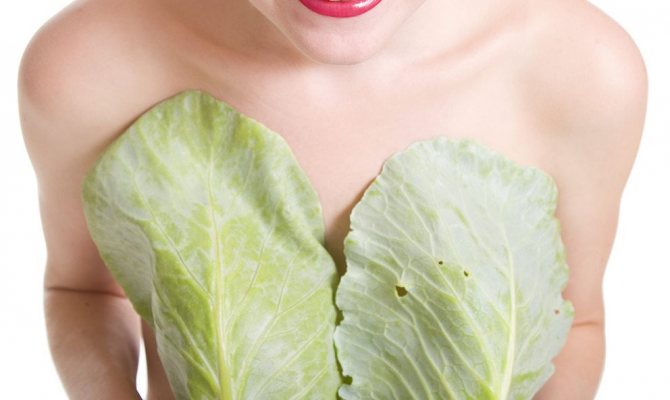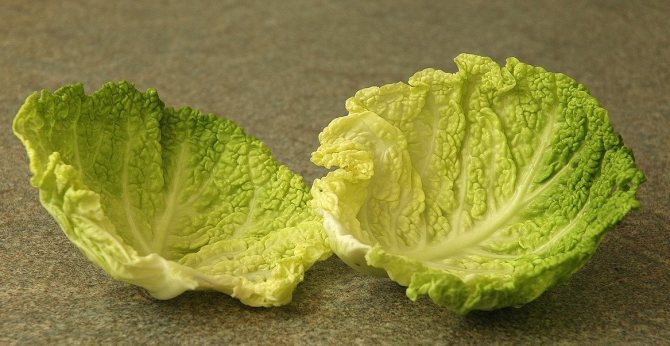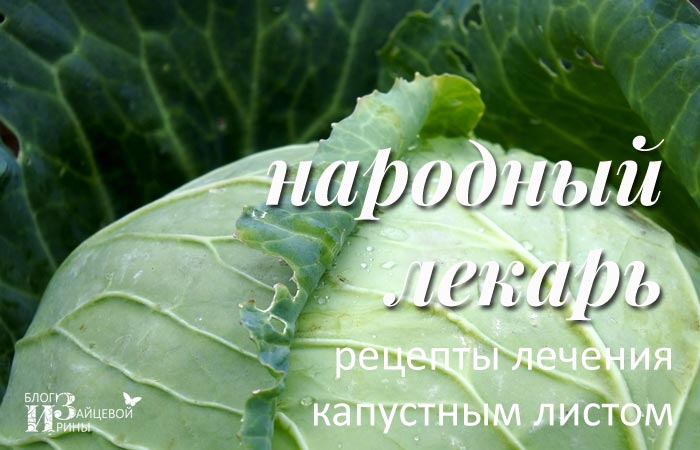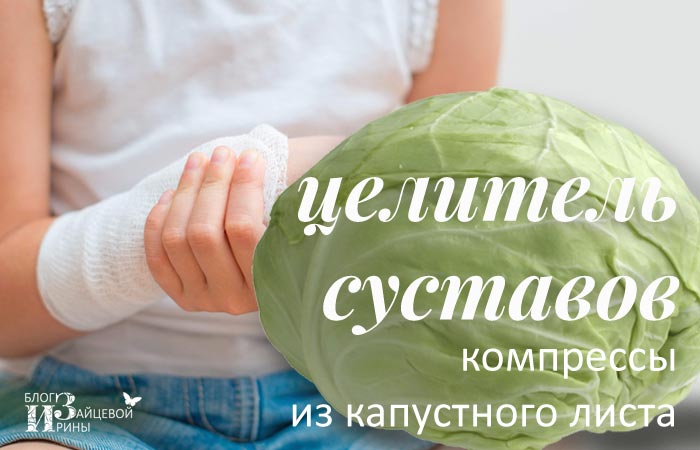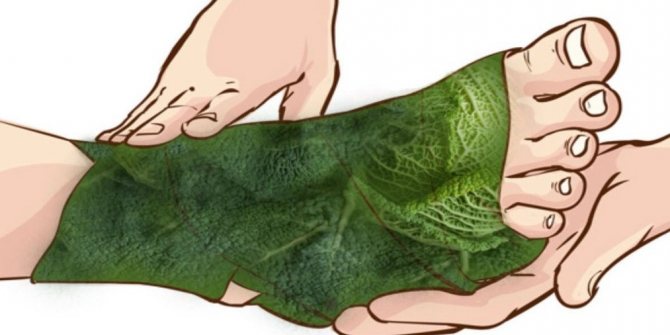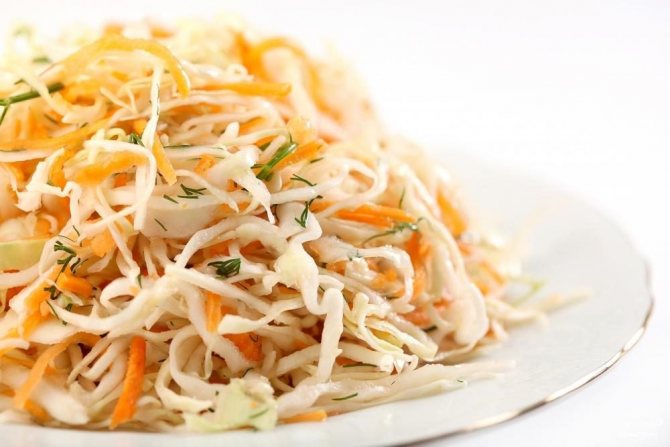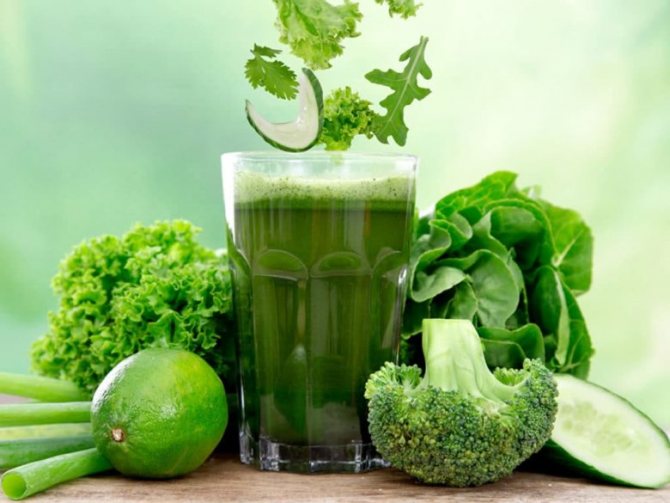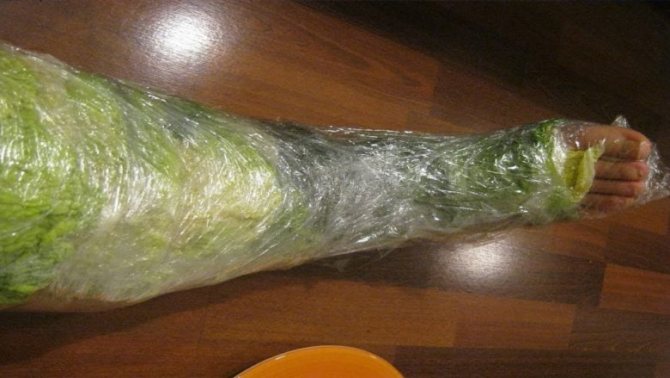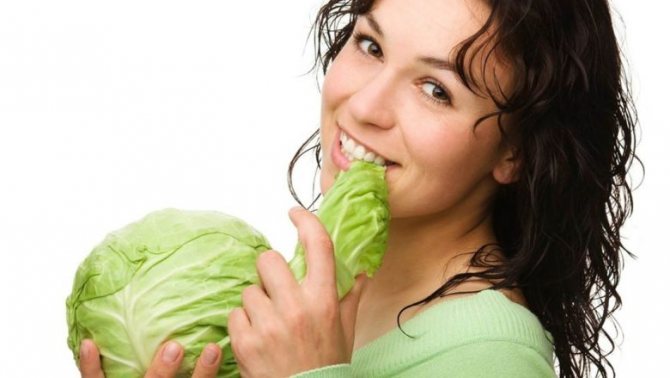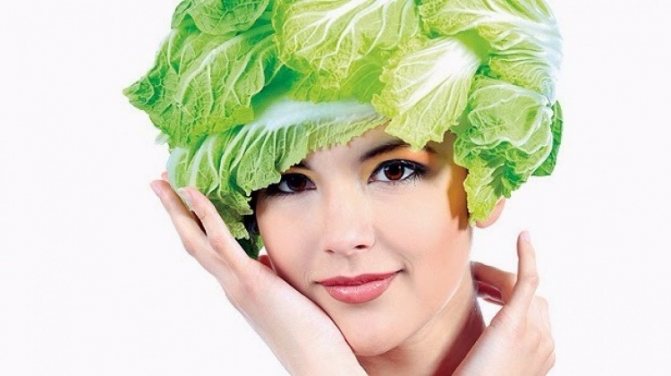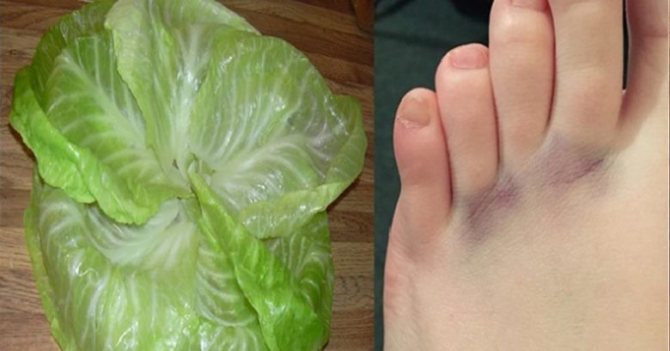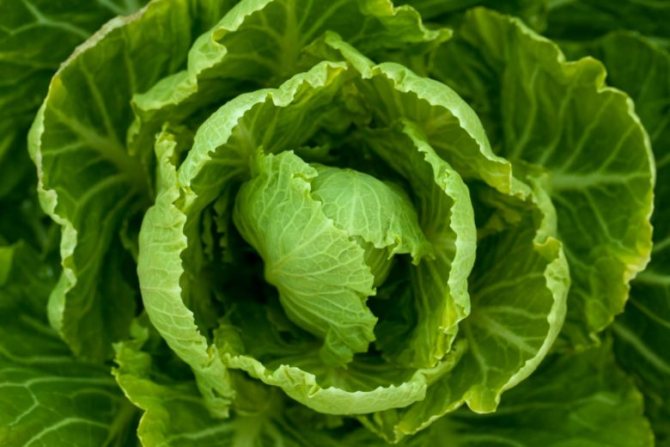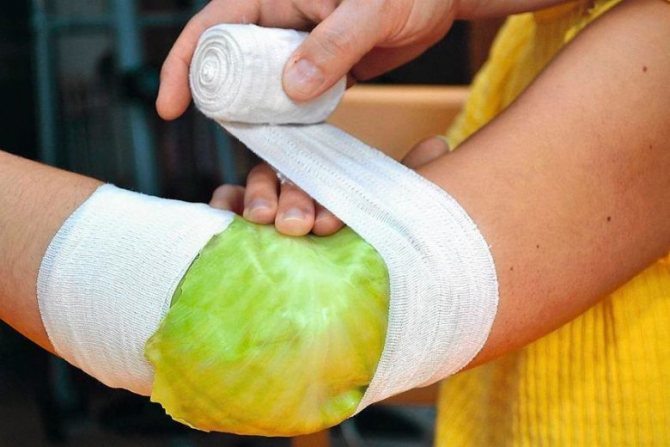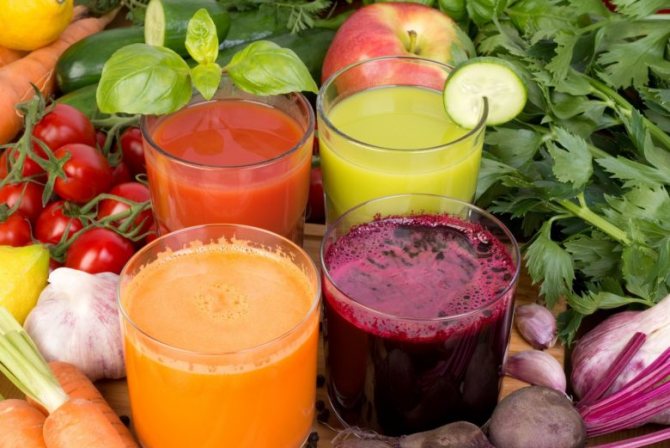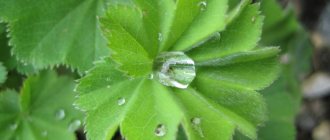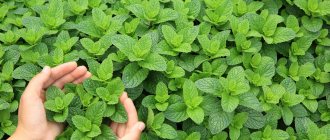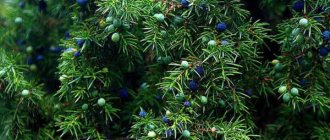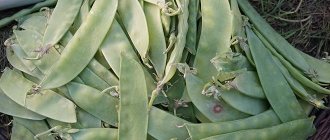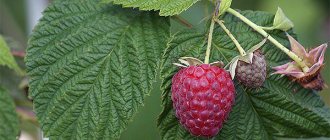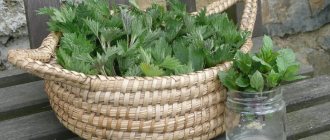Collard greens, what is it. Kale
Collard greens are grown in garden plots most often for ornamental purposes. There are a large number of hybrids that are food grade. To get a good harvest, you must follow the rules of agricultural technology.
Description of kale
Gardeners are attracted by curly cabbage not only for its decorative appearance, but also for its high content of vitamins and useful microelements. The vegetable contains: calcium, ascorbic acid, omega-3 amino acid and others.
Collard greens, what is it, characteristic:
- Collard cabbage is called in another way curly, browncol, grunkol cabbage;
- A distinctive feature of kale is that it does not form a head of cabbage. The vegetable consists of a loose rosette of leaves;
- The rosette grows from 30 to 90 cm in height. The diameter of an adult plant can vary from 50 cm to 100 cm;
- The leaf blade is thin in structure, but fleshy and juicy. The edges of the leaves are corrugated, like a fringe;
- The plant is biennial. In the first year, leaves are formed, in the second year, the vegetable begins to bloom;
- The color scheme of the leaves depends on the variety. It is green, red, burgundy, brown, purple. American cabbage is used as an ornamental plant;
- The plant is able to withstand small frosts, but with strong temperature changes and a decrease to -15 degrees, it slows down in growth and dies. Leaves that have been exposed to the cold grow even tastier;
- The culture is resistant to disease. Collard greens hardly get sick with cabbage fly;
- The leaves are slightly bitter to taste, reminiscent of radishes. So that they do not taste bitter, they are frozen or dipped in boiling water;
- The calorie content of cabbage is 50 kcal per 100 g. The product is often included in diet menus and healthy food.
Care rules
One of the most unpretentious species that requires virtually no maintenance. The main thing is choosing the right place and the absence of wind. In order to protect the planting from the proximity of groundwater, the beds can be raised. Another option is that the drainage layer increases to 15 cm, and nutritious fertile soil is poured on top.
Watering
The culture responds positively to timely watering.
Advice! For this type, the soil should always be slightly damp.
Watering is carried out daily, in the evening, with warm, settled water. Each supply of moisture must be accompanied by loosening of the soil. After the rain, it is advisable to do the same.
Mulching
To maintain the required moisture level, the soil around the cabbage must be mulched. Any vegetation, hay, peat or moss is suitable for these purposes.
On a note! It is not recommended to plant any other plants near this species: Keil is a solitary culture.
Another sign that the soil needs to be mulched is the appearance of diseased leaves. These can be white spots or decaying foliage ends. Damaged or diseased leaves should be removed immediately.
Fertilizers
Top dressing for healthy crop growth should be applied once a month.
Important! Failure to comply with the norms of applied fertilizers can lead to decay, first of the foliage, and then of the root system.
To maintain the plant in proper condition, it is necessary to add a solution from mullein or chicken droppings to the soil (200 g of organic matter is added to 1 bucket of water and infused for 24 hours). After watering, in order to avoid the reproduction of pests, the ground around the vegetable is sprinkled with dry wood ash.
Cabbage kale salad recipes. Kale Cabbage Salad
It is rare to see kale on sale. However, if you met her - feel free to buy, because today I will share with you a recipe for a salad with kale. Kale is more of a wild cabbage. Kale has tough ribs that are not used for cooking, but its green leaves are quite edible. This cabbage contains many amino acids, nine of which are essential - histidine, leucine, phenylalanine, valine and others. Compared to meat, the amino acids in feces are much easier to extract and absorb. Also, kale contains many vitamins and minerals, it has a very high content of vitamins A and C. Few people use kale for cooking, but in vain. So I suggest fixing that up and making a kale salad. One important point: to make the cabbage more juicy, it must be mixed with lemon juice, oil and salt and let it stand for a while. The Kale Rustic Salad recipe makes 4 servings.
To make a kale salad, we need:
kale - 1 bunch lemon - 1 carrots - 2 green onions - 2 stalks dried cranberries - 40 g sunflower seeds - 2 tablespoons olive oil - 4 tablespoons garlic - 1 clove balsamic vinegar - 2 tablespoons Dijon mustard - 2 tsp freshly ground black pepper - ½ tsp salt - 3/4 tsp
How to make kale salad:
1. Thoroughly rinse the cabbage and remove the tough ribs. Cut the lettuce into large pieces or you can tear it with your hands. 2. Wash the lemon, cut off half and squeeze the juice. To prepare the salad, we need 2 tablespoons of lemon juice. 3. Peel and chop the garlic. 4. Wash the carrots, peel and cut into thin slices. To prepare this salad, it is better to take small young carrots. 5. Thoroughly rinse the green onions and chop them finely. 6. In a large bowl, combine the kale with lemon juice and 1 tablespoon of olive oil. Sprinkle with salt (1/4 tsp). We crumple the cabbage with our hands for 2 minutes, so that it becomes soft. Set aside the bowl of cabbage. 7. In a small bowl, combine garlic, balsamic vinegar, Dijon mustard, ½ teaspoon of salt, freshly ground black pepper. Mix everything thoroughly. 8. Add 3 tablespoons of olive oil there. Stir again. 9. Add chopped carrots, green onions and cranberries to the cabbage. 10. Pour over the sauce and stir. 11. Sprinkle with toasted sunflower seeds and serve.
Kale cabbage salad is ready.
What can be the difficulties in growing
When growing cabbage in the shade and dense plantings, nitrates can form in the leaves... To reduce their number, at all stages of culture growth, biological products are used that increase immunity and reduce the content of nitrates.
Like many leafy crops, Redborough f1 withers and turns yellow on hot summer days... To prevent such phenomena in the midday hours, the plants are provided with light shading.
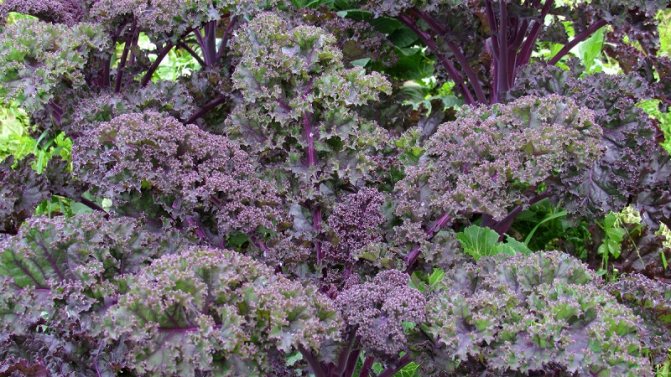
Redborne cabbage recipes. Features of growing redborough collard f1
Redbor f1 collard greens is a hybrid variety and belongs to the curly-leaved varieties of ornamental cabbage. Like many ornamental types of cabbage, it is a biennial plant. Therefore, it begins to bear fruit only in the second year. In most Russian summer cottages, they play an exclusively decorative role.But this is a waste of territory because this type of cabbage contains much more raw protein, sugar, vitamin C and carotene than other types of cabbage. This variety of cabbage tastes very good and does not require a lot of fat to cook.
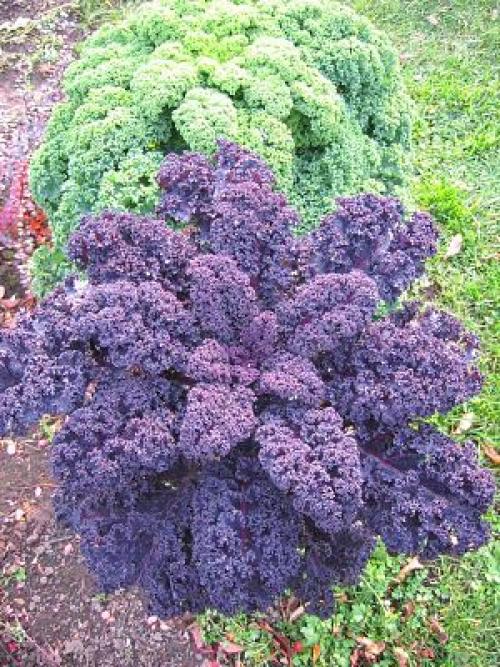

This hybrid has a very beautiful appearance. It reaches a height of 70-150cm. The leaves are colored maroon and shaped like a palm tree. The height of this plant depends on the season of planting. If you need to get a tall plant, then the seeds must be sown at the end of March. Then, after 30-40 days, cabbage bushes must be transplanted to a permanent place of growth. This type of cabbage is not afraid of frost and feels great even if it is covered with snow. Having transferred the first frosts, the leaves of this plant become softer and juicier.
The appearance of the f1 redborough kale depends on the amount of sunlight the plant is exposed to. Soil moisture is of great importance. This is especially true for the hot season. Before planting this variety of cabbage, it is necessary to fertilize well the plot of land on which it is planned to plant Redbor f1 collard greens.
Is it possible to give cabbage leaf to rabbits and piglets
Cabbage leaf is not only a medicinal product and food product, it is also food for some species of animals. People who keep rabbits and pigs sometimes notice that their wards have a special interest in this vegetable. However, do not allow animals to eat cabbage uncontrollably.
It can be given to older rabbits, but in small quantities and only as a treat. Pigs can also begin to introduce a small amount of cabbage into the diet (up to 300-400 g per day) already in adulthood. It is strictly forbidden to feed cabbage to animals during the period of gestation. It is important to observe the reaction - often such food leads to indigestion and bloating. A month before slaughter, it is necessary to stop feeding the animals with cabbage, as this negatively affects the taste of the meat.
The main types of cabbage with photos and names
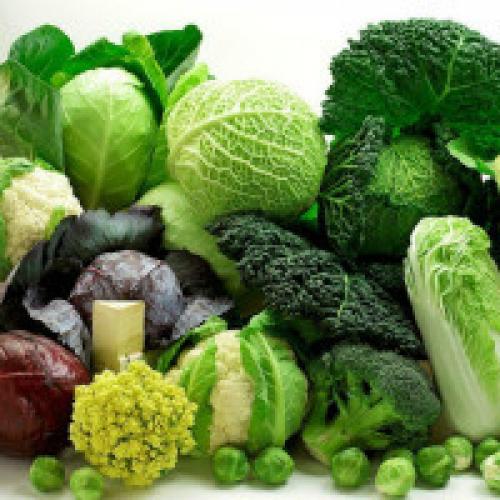

Cabbage is one of the healthiest vegetables around. But, in addition to the usual white cabbage, there are many more types of vegetables. We have prepared an overview article for you, from which you will learn everything about the common types of cabbage.
You will learn about the beneficial properties of cauliflower, red cabbage and other types of cabbage. A photo and
Types of cabbage, their photos, description and useful properties
In the understanding of the majority, cabbage is that white vegetable that is great for making borscht, stuffed cabbage and salads. Red cabbage is less popular, but in fact, the choice of cabbage is not limited to these two types.
There is such a wide range of this crop on the modern agricultural market that you can easily grow Chinese, Brussels sprouts and even Peking cabbage in your own garden. At the same time, almost all of these vegetables are cultivated by the seedling method, and each species has its own cultivation characteristics and a wide range of useful properties. Next, we will take a closer look at the main types of cabbage that can be grown in temperate climates, and their photos and detailed descriptions will help you make the right choice.
White-headed
It perfectly tolerates a harsh cold climate, but requires enough light, moisture and high soil fertility. Depending on the variety, white cabbage differs in the shape and weight of the heads. Due to its high yield and the possibility of long-term storage, this particular vegetable is considered the most common in our country (Figure 1).
Seedlings tolerate frosts well, but the formed plant stops growing at high temperatures (more than 30 degrees).The formation of heads of cabbage is also negatively affected by a lack of moisture. In addition, the plant, regardless of the growing phase, actively draws nutrients from the soil, therefore, to grow a large crop, additional fertilizers must be applied.
Figure 1. White cabbage at different stages of cultivation
A vegetable has many beneficial properties:
- Contains a lot of vitamin C, which is not destroyed even when fermented, so regular consumption helps to increase immunity;
- Vegetable juice is used to treat gastritis, ulcers and other diseases of the digestive system;
- The juice of this vegetable is also used in cosmetology, as it has a rejuvenating effect;
- The acids that make up the vegetable contribute to weight loss, preventing the conversion of excess carbohydrates into adipose tissue.
In addition, regular consumption of fresh or sauerkraut helps fight headaches and insomnia.
Redhead
Externally, red-headed varieties differ from white-headed varieties only in red-violet color (Figure 2). This vegetable also keeps well, and the cultivation technology is the same. There are early, mid and late varieties, and although it is usually consumed fresh, it is well suited for pickling and pickling.
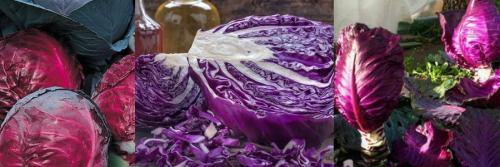

Chemical composition
Cabbage is a storehouse of valuable trace elements, the power of which can be used for medicinal purposes. This leafy vegetable contains vitamins, organic acids and minerals. All the beneficial properties of this plant are due to its rich composition. In order to skillfully use it for recovery, it is important to know what is included in:
- vitamins A, K, E, C, B9, B1, B2, B6;
- mineral compounds: potassium, calcium, zinc, sulfur, molybdenum, boron, chlorine, phosphorus;
- amino acids: arginine, lysine, methionine, tryptophan, threonine, histidine, valine;
- plant hormones;
- organic acids;
- polysaccharides;
- flavonoids and antioxidants.
The main advantage of the cabbage leaf, which is relevant when taken orally, is its low calorie content. You do not have to worry about your figure, using cabbage to treat various diseases. Moreover, it rarely provokes allergic reactions, and is also not toxic to children, so its therapeutic potential can be used even for them.
How is it used in cooking?
White cabbage is present on the table of people with Slavic roots throughout the year.
It is an indispensable ingredient for cooking:
- vegetable, meat and fish soups;
- cabbage soup and borscht;
- salads;
- casseroles;
- pies;
- dumplings;
- vegetarian cutlets.
Important! To prevent cabbage from darkening during cooking, use enamel cookware.
In addition, the product is pickled, stewed, boiled, fried, fermented, and also used to make fresh juice. It is good to combine a vegetable with other vegetables, as well as spices (cumin, anise, coriander, black pepper), apple and citrus juice (tangerine, orange), cranberries, lingonberries. In this case, prolonged heat treatment is unacceptable, since the structure and nutritional value of plant fibers are lost. To speed up the cooking process, it is recommended to chop fresh leaves with a knife or grater.
Contraindications
- myocardial infarction
- acidity gastritis
- acute inflammation of the urinary tract
- when breastfeeding
- pancreatitis
- after abdominal surgery (before healing)
- flatulence
- cruciferous allergy
- dermatitis
- hemangioma on the skin
- endometritis
- Graves' disease
For all types of dermatitis, doctors advise to exclude any dishes from white cabbage due to a possible exacerbation of the disease. Due to the excessive load on the digestive tract, this vegetable is also not recommended for endometritis; it is better to include cauliflower and broccoli in the diet.
Some doctors prohibit white cabbage for Graves' disease, because they believe that it contributes to the development of goiter.But all doctors agree that in diseases of the endocrine system associated with iodine deficiency, seaweed is extremely useful.
We make a compress correctly
For cabbage treatment to give a positive result, you need to carry it out correctly. It is advisable to use very fresh cabbage, ideally from your own garden. It should be free of stains and rot, wash the head thoroughly before use.


Blanching cabbage leaves for compress
In some cases, you can take the outer leaves from the head of cabbage, and in others, only tender leaves from the middle. Cabbage juice has a healing effect, so the leaves must be crushed so that they give as much juice as possible.
Attention! Place the cabbage tightly on the sore spot. It is desirable that there are several layers of softened leaves overlapping each other.
In many recipes, a vegetable is mixed with an egg, honey, mustard, and various medicinal herbs. Only sterile sheets are applied to open wounds, for this they are pre-poured with boiling water. Never use cold compresses, especially when it comes to joint diseases and colds.
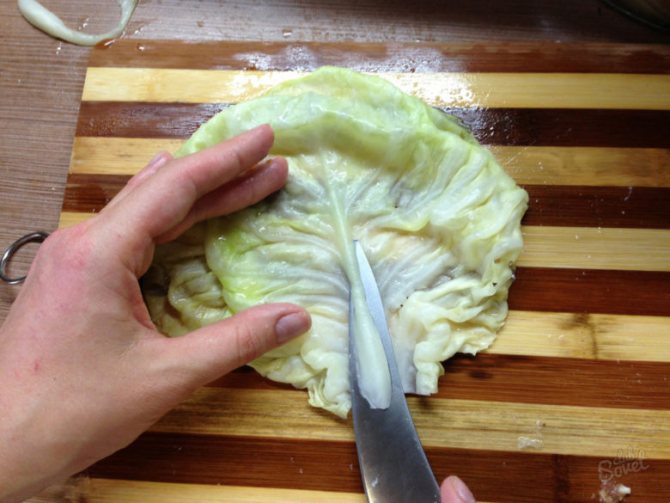

Preparing cabbage leaves for compress - cutting off coarse veins
If the cabbage is from the refrigerator, then the leaves must first be warmed. To do this, they can be placed in hot water for a few minutes. The leaves should adhere very tightly to the diseased area so that the juice is absorbed into the skin.
Advice! Always put plastic on top of the cabbage. The cling film is ideal for these purposes. It will not allow the juice of the plant to come out, be absorbed into the bandage, and all the beneficial substances will act as intended.
Be sure to fix the healing compress well so that it does not slip, but also does not squeeze the sore spot, sometimes the bandage must be worn for at least 8 hours. By fulfilling these conditions, you will only benefit your body.
However, for all its useful properties, cabbage has some contraindications. Read them before starting treatment.
Healing properties
It is generally accepted that cabbage leaves can cure or alleviate a number of diseases. This plant is known for the following medicinal properties:
- significant analgesic effect;
- removal or reduction of inflammation, direct impact on its focus;
- fights bacterial contamination;
- has an active diuretic effect;
- relieves swelling and bruises;
- normalizes metabolic processes, improves digestion;
- saturates the body with the necessary vitamins and minerals.

